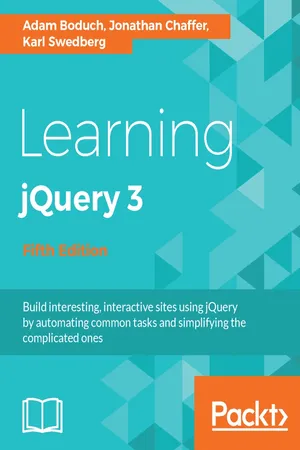
- 448 pages
- English
- ePUB (mobile friendly)
- Available on iOS & Android
Learning jQuery 3 - Fifth Edition
About This Book
Create efficient and smart web applications with jQuery 3.0 using this step-by-step practical tutorialAbout This Book• Create a fully featured and responsive client-side application using jQuery• Explore all the latest features of jQuery 3.0 and code examples updated to reflect modern JavaScript environments• Develop high performance interactive pagesWho This Book Is ForThis book is ideal for client-side JavaScript developers. You do need to have any previous experience with jQuery, although basic JavaScript programming knowledge is necessary.What You Will Learn• Create custom interactive elements for your web designs• Find out how to create the best user interface for your web applications• Use selectors in a variety of ways to get anything you want from a page when you need it• Master events to bring your web pages to life• Add flair to your actions with a variety of different animation effects• Discover the latest features available in jQuery with the latest update of this incredibly popular title• Using jQuery npm PackagesIn DetailIf you are a web developer and want to create web applications that look good, are efficient, have rich user interfaces, and integrate seamlessly with any backend using AJAX, then this book is the ideal match for you. We'll show you how you can integrate jQuery 3.0 into your web pages, avoid complex JavaScript code, create brilliant animation effects for your web applications, and create a flawless app.We start by configuring and customising the jQuery environment, and getting hands-on with DOM manipulation. Next, we'll explore event handling advanced animations, creating optimised user interfaces, and building useful third-party plugins. Also, we'll learn how to integrate jQuery with your favourite back-end framework.Moving on, we'll learn how the ECMAScript 6 features affect your web development process with jQuery. we'll discover how to use the newly introduced JavaScript promises and the new animation API in jQuery 3.0 in great detail, along with sample code and examples.By the end of the book, you will be able to successfully create a fully featured and efficient single page web application and leverage all the new features of jQuery 3.0 effectively.Style and approachCreate efficient client-side apps that look great and run seamlessly across all devices with this step-by-step practical guide. There are illustrative examples for those who need extra help to get started with jQuery web development.
Frequently asked questions
Information
Appendix B – Quick Reference
Selector expressions
Simple CSS
| Selector | Matches |
| * | All elements. |
| #id | The element with the given ID. |
| element | All elements of the given type. |
| .class | All elements with the given class. |
| a, b | Elements that are matched by a or b. |
| a b | Elements b that are descendants of a. |
| a > b | Elements b that are children of a. |
| a + b | Elements b that immediately follow a. |
| a ~ b | Elements b that are siblings of a and follow a. |
Position among siblings
| Selector | Matches |
| :nth-child(index) | Elements that are the index child of their parent element (1-based). |
| :nth-child(even) | Elements that are an even child of their parent element (1-based). |
| :nth-child(odd) | Elements that are an odd child of their parent element (1-based). |
| :nth-child(formula) | Elements that are the nth child of their parent element (1-based). Formulas are of the form an+b for integers a and b. |
| :nth-last-child() | The same as :nth-child(), but counting from the last element to the first. |
| :first-child | Elements that are the first child of their parent. |
| :last-child | Elements that are the last child of their parent. |
| :only-child | Elements that are the only child of their parent. |
| :nth-of-type() | The same as :nth-child(), but only counting elements of the same element name. |
| :nth-last-of-type() | The same as :nth-last-chil... |
Table of contents
- Title Page
- Copyright
- Credits
- About the Authors
- About the Reviewer
- www.PacktPub.com
- Customer Feedback
- Dedication
- Preface
- Getting Started
- Selecting Elements
- Handling Events
- Styling and Animating
- Manipulating the DOM
- Sending Data with Ajax
- Using Plugins
- Developing Plugins
- Advanced Selectors and Traversing
- Advanced Events
- Advanced Effects
- Advanced DOM Manipulation
- Advanced Ajax
- Appnedix A – Testing JavaScript with QUnit
- Appendix B – Quick Reference